By Ayla Ellis and Eby Kangleon
Kaeng Krachan National Park has long had a reputation among birders and nature lovers as one of Thailand’s richest forest ecosystems. Tucked away in Phetchaburi province — and sprawling beyond into neighboring regions — this massive park is a haven for birds, mammals, and insects alike. It’s a place where hornbills perch by the roadside, partridges creep silently through the underbrush, and gibbons call loud and clear through the canopy. For us, the national park was more than a destination. It was a long-awaited trip.
We had talked about visiting Kaeng Krachan for almost a year. Ever since we became new birders, it had hovered in our minds like a bright-winged promise. We had watched YouTube videos of leopards on forest trails, hornbills flying right overhead, pittas hopping into view, and felt the pull grow stronger. We read trip reports, pored over checklists, and daydreamed about colorful lifers. With our research behind us, it was time to turn plans into reality.
Day 1: In with the Rain
Our trip began in Bangkok, where we boarded a minibus at the Southern Bus Terminal (Sai Tai Mai) headed for Phetchaburi. The first leg was smooth, but as soon as we transferred to a van bound for Kaeng Krachan town, the skies opened up. Rain poured as we sat quietly, watching fields blur together. By the time we reached town, the driver dropped us off at the local police station — right in the middle of a heavy downpour.
That’s where we met Mr. Samarn and his wife, Auntie Om, who greeted us with cheerful waves and umbrellas. They took us on a 30-minute drive into the forest, toward their birding lodge: Samarn Bird Camp. Even through the rain, the scenery was captivating — thick trees, misty roads, and the occasional glint of bird wings.
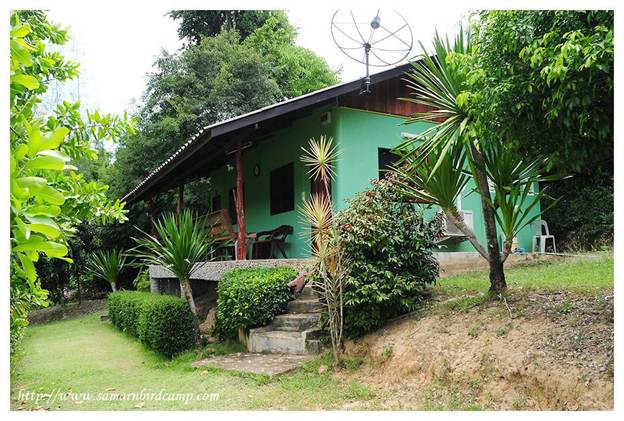
Samarn Bird Camp isn’t just a place to stay; it’s part of the forest land. Tucked into a hillside and surrounded by native trees, the camp is part lodge, part bird sanctuary. Mr. Samarn, a longtime bird guide with decades of experience, has cultivated the grounds to attract birds all year round. The property is dotted with fruiting trees that draw bulbuls, leafbirds, and sunbirds daily. There are private guest rooms and cabins, all simple but clean and comfortable, each with their own porch to sit and watch the greenery breathe.
What makes the camp special is the way it blends into the environment. Bananas and papaya attract both common and rare birds. There’s an orchard where butterflies drift past in lazy spirals, and quiet corners perfect for scanning the treetops. Meals are prepared by the aunties in the kitchen, and served in a communal, open-air dining area that looks out into the greenery. One corner holds a shrine-like offering table — not just for spirits, but for birds too, as it turns out. The bulbuls think it’s their buffet.
That first night, we unpacked slowly, still damp from the rain but already buzzing with excitement.
Day 2: Bird Pond Hide
We woke early, our bodies still on city time but our minds already tuned to forest. Even before breakfast, the camp was alive with birds. An Oriental Pied-Hornbill landed on a tree just across the road. Ashy and Greater Racket-tailed Drongos darted overhead. Black-crested, Streak-eared, and Sooty-headed Bulbuls flitted through the banana stands near the kitchen. A pair of Ornate Sunbirds flitted in, and we almost missed the Golden-fronted Leafbirds as they camouflaged well with the foliage. We sat in the dining area with ginger tea and watched them feed, feeling as if we were the guests and they were the hosts.

After a light breakfast, we headed out with Mr. Samarn to the bird hide known locally as “Bo Bird” — the Bird Pond. He drove and stayed with us through the day, even bringing us our packed lunch. The hide was built with intention: shaded, open enough for airflow but dark enough for birds and other animals to approach, and with a clean restroom nearby — a small miracle in the middle of the forest.
From 8 a.m. until 4 p.m., we watched the pond and its quiet magic. Early in the day, it was busy with activity. Groups of Greater Necklaced Laughingthrushes bounced around the edges, alternating with a mixed flock of Lesser Necklaced Laughingthrushes and White-crested Laughingthrushes. Puff-throated Babblers and Pin-striped Tit-Babbler scurried through the undergrowth, and Malaysian Pied-Fantails flared their tails at every leaf. Hair-crested Drongos and Racket-tailed Treepies zipped between branches, and a pair of Greater Yellownapes gave us brief but clear views. A pair of Common Flamebacks appeared separately, lighting up the shadows with their fiery back. A family of Red Junglefowls — hen, chicks, and all — strutted across the clearing like they owned it. They took turns at the pond’s edge, sharing space with a Spotted Dove cooing softly from a nearby perch.

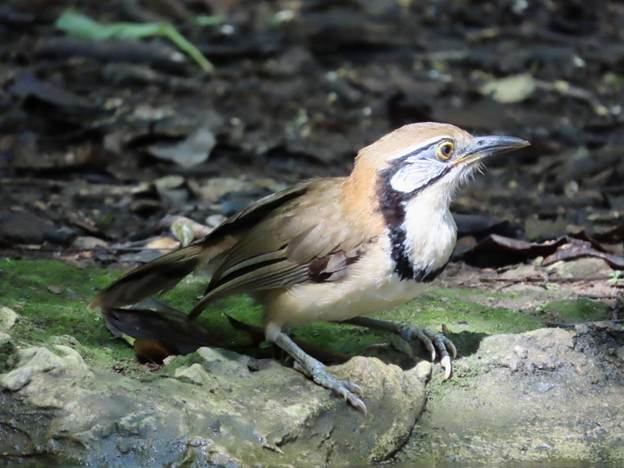
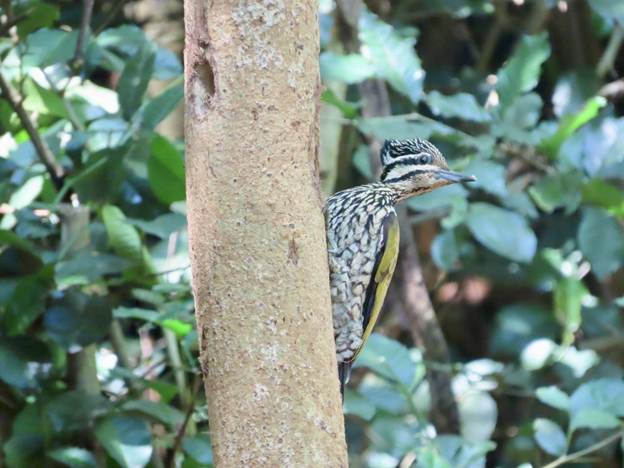
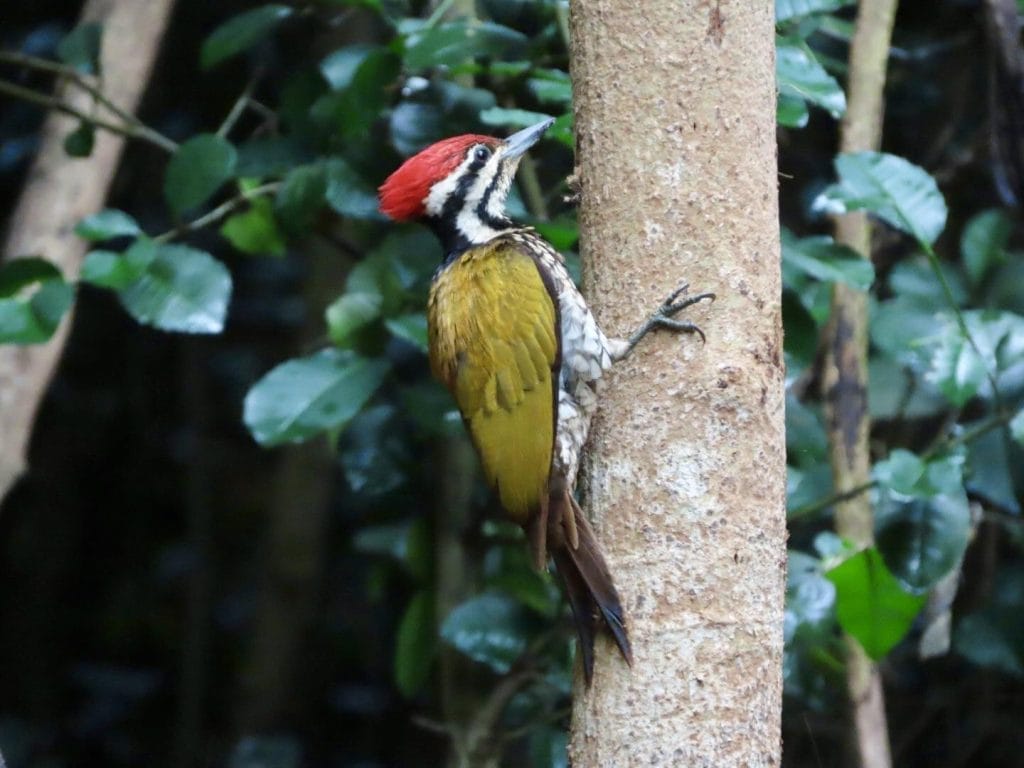



A few squirrels also made appearances, lingering on branches or foraging nearby. They stuck around long enough for a good look, but not knowing much about squirrels, we couldn’t confidently identify them.
Shortly before the hide grew quiet, an Oriental Pied-Hornbill flew in and picked apart a ripe papaya, then wiped its beak on a mossy branch with deliberate care — a simple act that made us both gasp in awe.
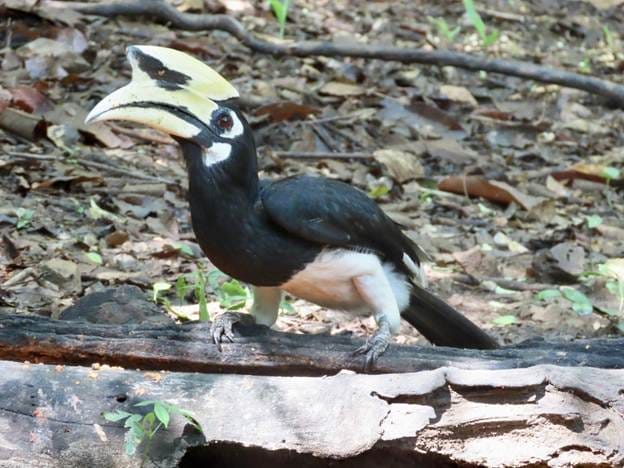
A Lesser Mouse-deer also wandered in for a drink, lingering at the water’s edge for several minutes before quietly disappearing back into the undergrowth.

As lunch approached, the skies darkened too. The hide fell into a lull, save for the soft whistles of a White-rumped Shama and the fluttering of an Indochinese Blue Flycatcher. Then a light rain passed through, and most of the other visitors packed up and left. But we stayed.
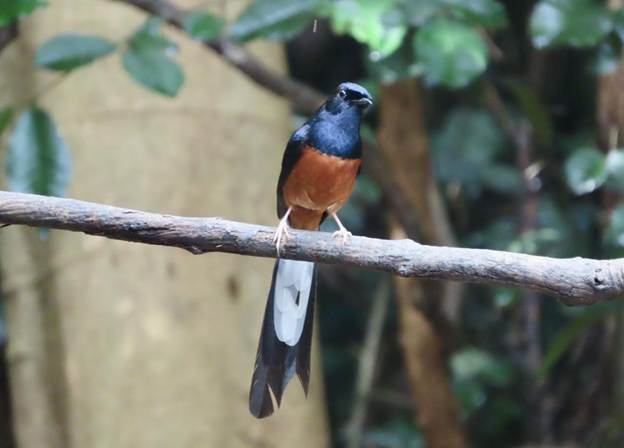
That’s when the partridges arrived.
In the soft light of early afternoon, a pair of Scaly-breasted Partridges crept slowly along the forest floor, so cautiously we nearly missed them. Then came the Bar-backed and Ferruginous Partridges, weaving through the low plants with the kind of quiet intensity only partridges seem to have.

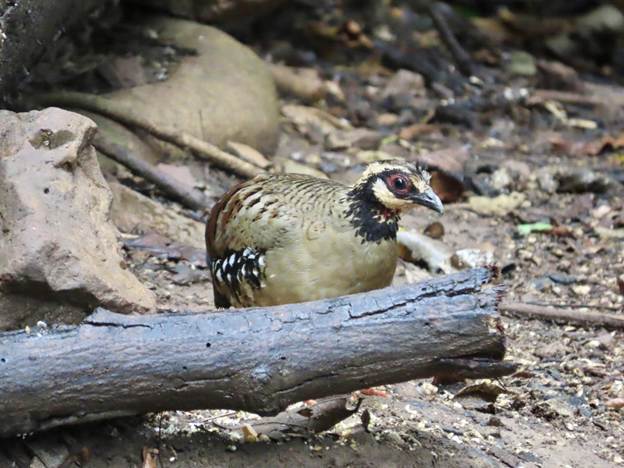
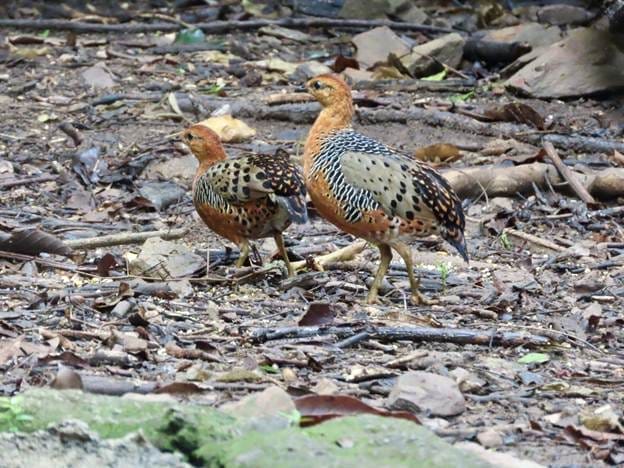
Later, to everyone’s surprise, a Blue-winged Pitta hopped into view. Mr. Samarn’s face lit up. “Didn’t expect that one today,” he said, clearly delighted. It felt like the forest was testing our patience — and then decided to let us win.
Time dissolved as the light shifted. Sometimes, we said nothing for hours. Just looked, and listened.
By 4 p.m., the forest had started to dim. The birds quieted, and the shadows stretched longer across the clearing. We packed up slowly, still soaking in the last stillness of the hide.
Outside, we glimpsed Red-wattled Lapwings and Eastern Cattle Egrets in the open fields. An Asian Emerald Dove darted between trees on the drive home.
It was a great spot — quiet, comfortable, and well thought-out. A good hide makes all the difference, and this one lets us settle in and really watch the forest. We left feeling satisfied, already wondering what tomorrow might bring.
Day 3: Into the Canopy
We left early again. In the dining area, a Dark-necked Tailorbird perched nearby and sang to us while we drank our tea. It joined the now-familiar cast of bulbuls, sunbirds, and leafbirds that were present during breakfast.
We climbed into Mr. Samarn’s sturdy truck and began the ascent into the park proper. The air cooled as we gained elevation, the forest shifting around us — taller trees, quieter roads, and a dimmer, greener kind of light filtering through the canopy. Somewhere on the way, a Black-capped Kingfisher zipped past our vehicle, leaving only a flash of color and a sharp call behind.
A few meters ahead, Mr. Samarn slowed down and pointed to a low-hanging branch. Coiled loosely like a vine was a bright green Leaf Snake, its body still and graceful, its scales almost blending in with the foliage. It didn’t seem bothered by us — just rested there, half-hidden in the morning shade. We all leaned in for a better look, impressed by how perfectly it camouflaged in its surroundings.
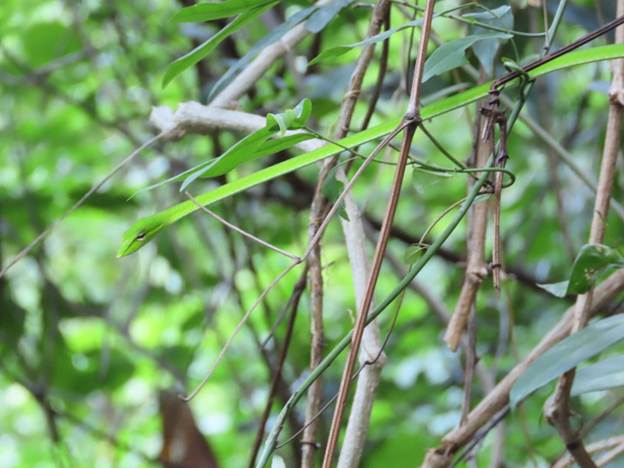
The wildlife didn’t wait long. The forest around us echoed with sound — and not just birds. Whooping gibbons called across the canopy, their voices wild and thrilling. Dusky langurs moved above us in the trees, leaping from branch to branch with graceful ease, pausing only briefly to peer down at us before disappearing again. Butterflies floated by constantly, in every direction — orange, green, even bright blue. There were so many that we started joking about taking up butterfly watching.
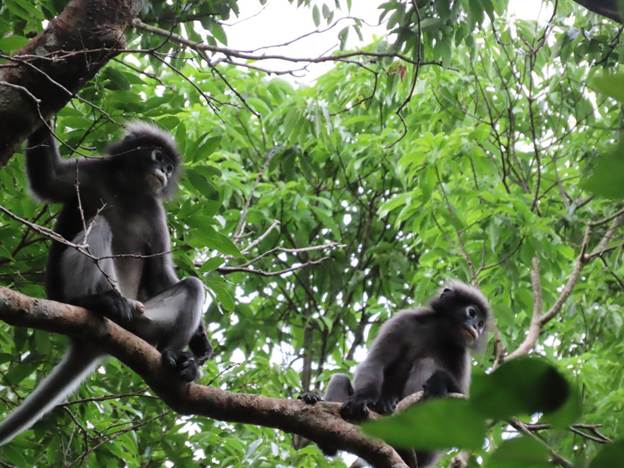

We spent the day hopping between key sites, each one full of possibility. While scanning for a Silver-breasted Broadbill, we saw Thick-billed Green Pigeons, Blue-eared Barbets, Dollarbirds, Ashy Drongos and Greater Racket-tailed Drongos perched in the distance.

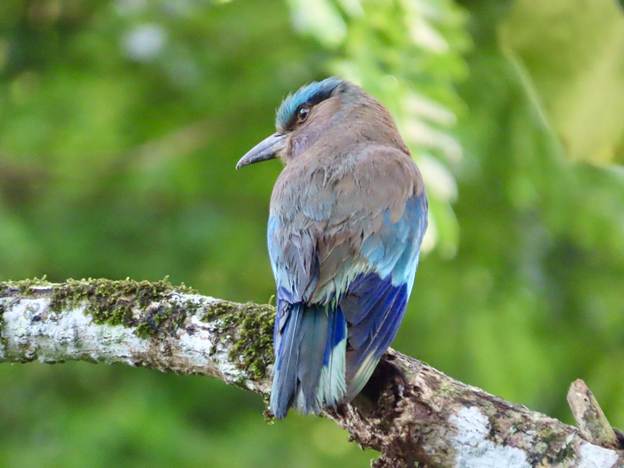
We walked along the road for about an hour, but the broadbill eluded us that morning. Still, the forest had other surprises. A Greater Coucal watched us quietly from a low branch, its deep eyes following our movements. Nearby, a Bar-winged Flycatcher-shrike paused to preen — Mr. Samarn noted it was a little early in the season for them, making the sighting feel even more special.
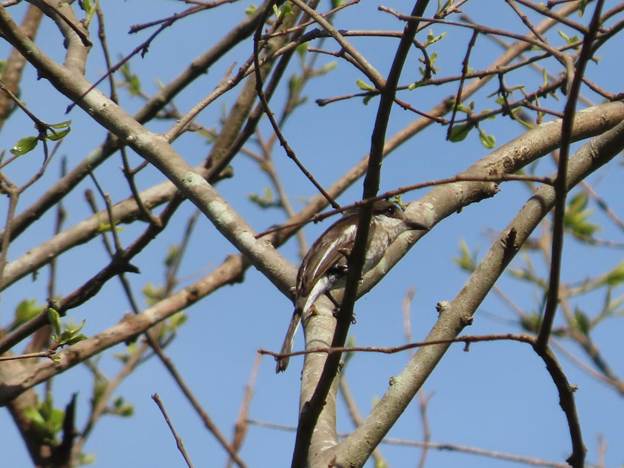
We drove to a spot where we waited quietly, hoping for a glimpse of the elusive Golden-crested Mynas. Overhead, a Crested Serpent-Eagle circled in wide, lazy arcs, its call echoing faintly through the trees. Then — without fanfare — the mynas arrived, flying straight to a hole high in the tree trunk. Not long after, a striking Black-and-red Broadbill appeared in the same patch, prompting quiet murmurs of excitement from everyone watching.
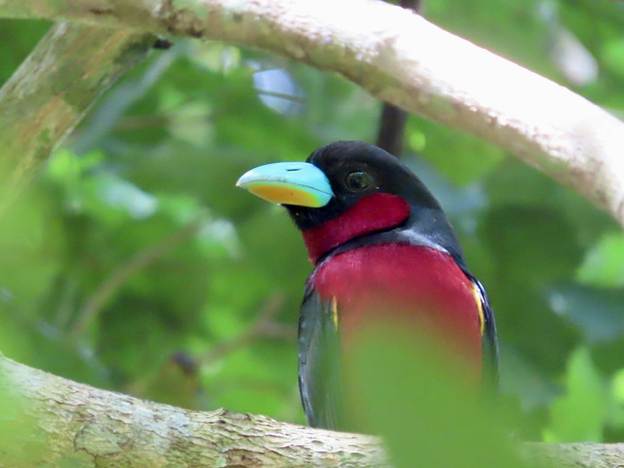
We moved on, as Mr. Samarn wanted for us to reach the peak of Phanoen Thung before dark. At one point, the driver spotted some movement and pulled over — a quick scan of the trees revealed a Grey-headed Woodpecker quietly working its way up a trunk.
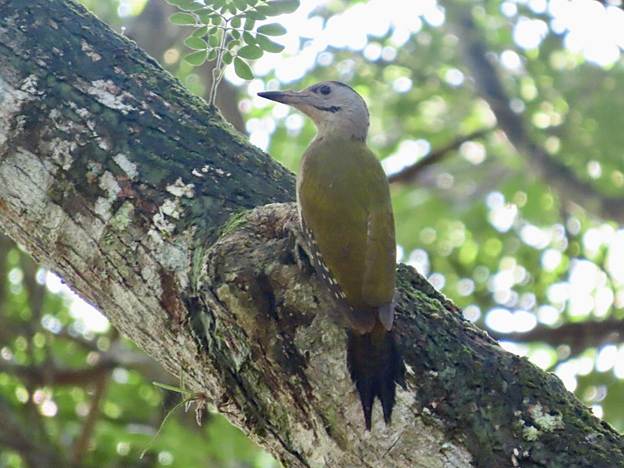
Then we rounded a corner and found a small crowd gathered near the roadside — a commotion was building. We pulled over just in time to catch a Banded Broadbill perched high above. Its purple-pink sheen and broad bill looked almost cartoonish — one of those birds you dream of seeing and then can’t believe is real when you finally do.
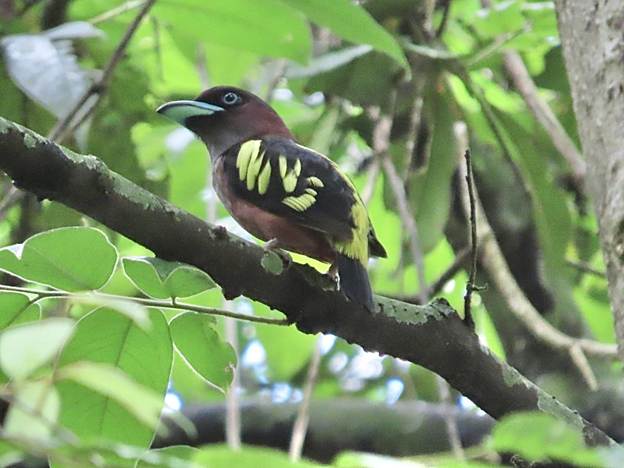
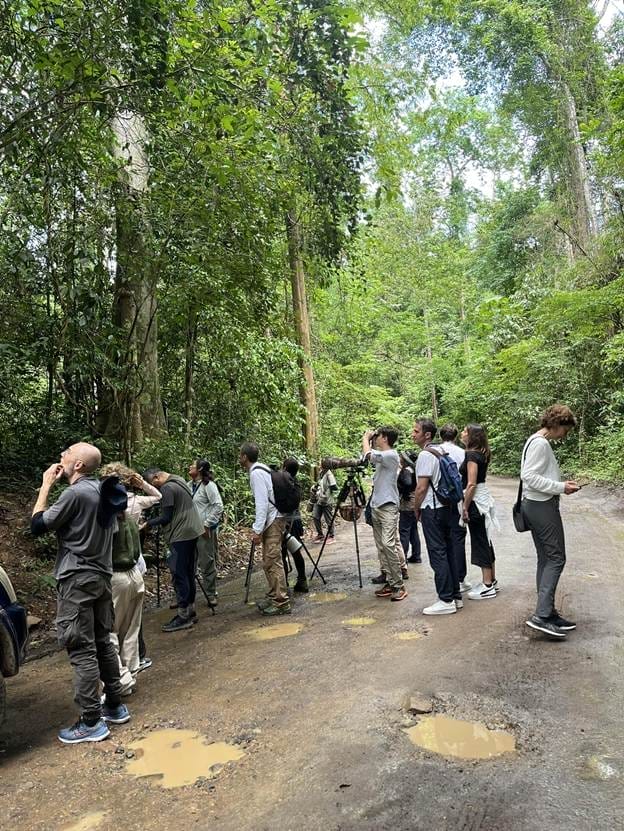
Birding with Mr. Samarn and his driver was a joy — their eyes and ears were sharp. At one point, his driver quietly pointed upward. High above us, barely distinguishable from a tangle of branches, was a White-fronted Scops-Owl. Completely silent, perfectly still — it could’ve been missed entirely if not for experience and luck.
Later, Mr. Samarn led us down a short trail. There, on a gnarled, mossy branch sat an Orange-breasted Trogon. We held our breath. It was our first trogon, and seeing one so close — the vivid orange belly, the patterned tail — felt like a scene pulled from a storybook. We watched it for a few minutes before it slipped away into the thick brush.

As we reached one trailhead, a group of photographers were staked out, waiting for the elusive Blue-capped Kingfisher. We joined them for a while, watching shadows move across the water, but the sky began to darken. With the light fading, we made the call to move on.
Not long after, we settled in quietly near a clearing where bee-eaters were known to visit. We waited. And waited. Almost an hour passed before we finally spotted them — Red-bearded Bee-eaters gliding in, elegant and bright. They stayed longer than we expected, hawking insects mid-air and returning to the same perch again and again. We watched their every move, mesmerized. In the same patch, Blue-throated Barbets also zipped by, a little too fast for our cameras.
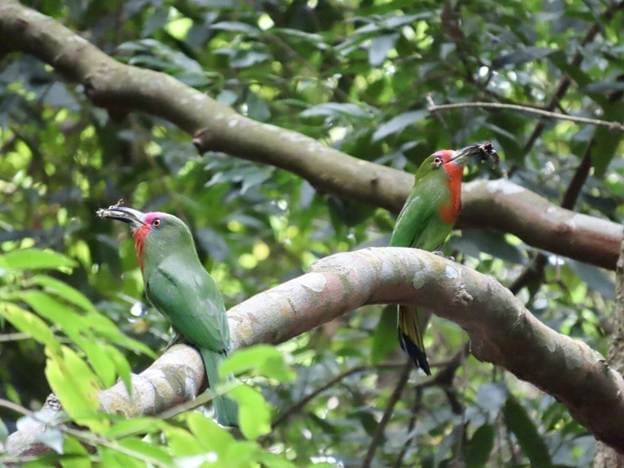
At the summit of Phanoen Thung, we paused to take in the view and spotted a Mountain Imperial-Pigeon perched like royalty at the edge of the canopy, chest puffed out and perfectly framed against the clouds.
After that, we made our way back toward camp as the sky began to darken. At one point, we stopped near the roadside where recent signs had suggested a leopard might cross. Mr. Samarn asked us to stay silent, and for a long while we did — listening, watching, waiting. But the forest stayed still, and the leopard didn’t appear.
On the way down, we also paused when we noticed some movement in the undergrowth — a Collared Babbler, bouncing lightly through the leaf litter, its call brief and sharp before it vanished again.
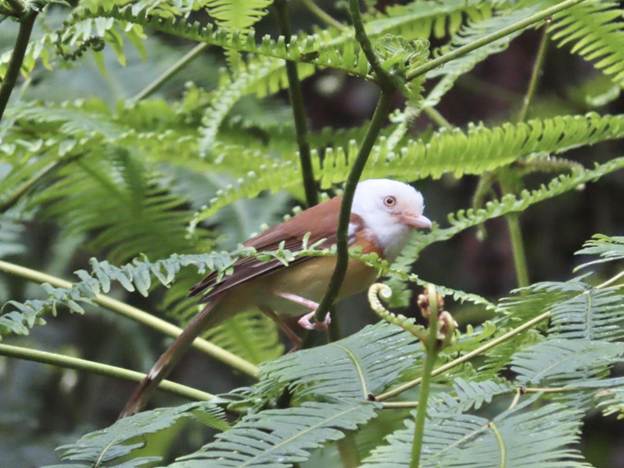
Some birds, like the Great Hornbill and Silver-breasted Broadbill, remained out of sight too. But that’s part of what makes birding so compelling — not everything reveals itself, and the unknown keeps you coming back.
As we continued the drive back, the light fading fast, a sudden commotion by the roadside made us stop. A group of photographers had gathered and were motioning quietly toward the ground. One of them pointed, and that’s when we saw it — a Large-tailed Nightjar sitting calmly beside the road, almost invisible against the forest floor. Nestled close beside it was a tiny chick, equally still. They didn’t seem bothered by our presence, just part of the twilight hush settling over the forest. A quiet, unexpected end to a long, rich day.
Day 4: Farewell to the Forest
Our final morning was quiet and unhurried. A bowl of warm rice soup for breakfast, followed by an unspoken understanding that we didn’t quite want to leave just yet.
Mr. Samarn and Auntie Om drove us back to Phetchaburi, where we caught a minibus back to Bangkok. The rain had passed. The skies were clear. But our heads were still full of green canopies and distant bird calls.
We went to Kaeng Krachan for the birds — and we got them, in numbers and diversity that amazed even seasoned birders. But what stayed with us more was the feeling of being welcome. The camp, the forest, the people — they each offered their own kind of quiet hospitality.
At the heart of it all was Mr. Samarn, the soft-spoken owner of the camp. A seasoned wildlife expert who speaks English and knows the forest intimately, he guided us with a calm confidence that made every moment feel generous. His knowledge, warmth, and quiet dedication deepened our appreciation for everything we saw.
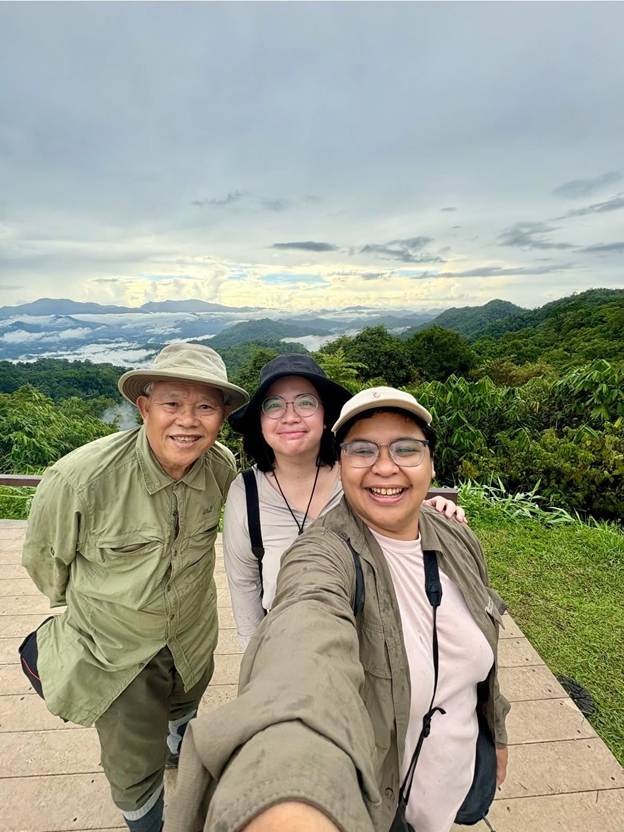
There’s something humbling about birding in a place like Kaeng Krachan. The birds don’t always show. The roads are rough. The weather changes quickly. And yet, every moment feels like a gift. For relatively new birders like us, the trip reminded us why we started in the first place: for the surprise of color in the green, for the stillness before flight, for the people who love the forest as much as we’re learning to.
It’s the kind of trip that doesn’t shout its highlights. It just lets them unfold — if you’re willing to wait, watch, and listen.

I immensely enjoyed and greatly inspired reading your well-written article and the photos you shared. Now I too am excited about going to Kaeng Krachan. Could you share some tips on how to go about such a trip, including Mr Samarn’s contact info? Thank you and happy birding!